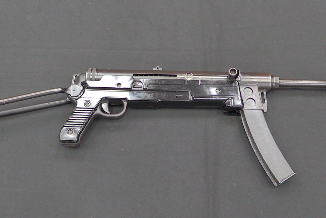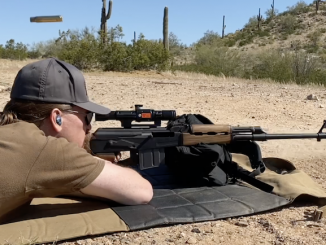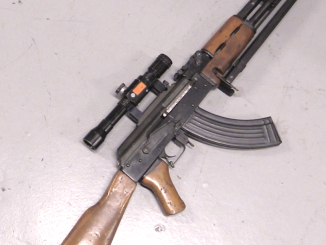In the 1970s, the Yugoslav Army decided that it wanted a semiautomatic marksman’s rifle, something akin to the Romanian PSL or Soviet Dragunov. Not having the technical data package to manufacture the SVD, the Zastava factory set about scaling up its M70 Kalashnikov to meet this requirement. The result was the M76, chambered for the 8mm Mauser cartridge. It fed from a 10-round detachable magazine and was fitted with the Zrak ON-M76 scope, a simple but robust 4 power optic with a BDC cam for an elevation adjustment and basic rangefinder included in the reticle.
The M76 would be the JNA’s squad marksman rifle for about 15 years, until replaced by the M91, a similar design using 7.62x54R ammunition. A few thousand of these rifles eventually found their way into the United States, like this one.




Looks like a blend of east and west again. “Eastern” hardware (receiver and operating system) but “western” cartridges (good performance proved during the previous wars and better feeding geometry), how much else can be done to defy conventional logic?
“(…)“western” cartridges(…)”
Are you sure about that? 8 mm Mauser was developed in Germany which years later was divided (unequally in terms of area) into east part (DDR) and west part (Bonn Germany), so… which one was true Germany?
The one that’s left?
Sorry, couldn’t help myself.
Now I see my question was ill-formed and thus might be misunderstand.
To be more precise:
Where exactly was 7,9 x 57 mm cartridge developed? In which city, was it west or east of future iron curtain? Answer to this question should ultimately positively finally point whetever cartridge is actually “west” or “east”, if we need to assign it to one of them.
Daweo, to answer your question:
The location of 7,9 mm development was the cluster of state armament factories plus the Gewehr-Prüfungskommission, all at Spandau.
Geographically east of the later iron curtain, but actually part of the later British sector of Berlin.
Geographically, all of the German-speaking lands have been understood to be Central Europe. The post-WWII division of Germany into a British, French, U.S. American and Soviet sector led to a division between an ostensibly “socialist” SED-led GDR of 17 million people in the “East” and over 60 million in the BRD “West.”
The division behind the Churchill-named “Iron Curtain” lasted 40 years, which ain’t much in world historical terms. Germany, the Czech Republic, and Hungary shortly returned to Central Europe instead of the “Eastern Europe” to which they’d been consigned for Warsaw Pact/ Soviet-aligned status in a rather artificial way.
So your claim about 7.65×53-mm, 7×57-mm and 7.92×57-mm being developed in “eastern Europe” versus Central Europe is both ahistorical, and a bit asinine actually.
As for Yugoslavia, the service cartridge there had been a 7×57-mm hold over from the days of Serbia and Royalist Yugoslavia, but shortly became 8-mm due to the German dismemberment of the Union and the consequent Tito victory at the end of WWII. Thus, Yugoslavia adopted arms from Western Europe (the 22-mm Nato rifle grenade), the East, and Central Europe of yore… and made their own arms, e.g. the externally resembling PPSh, but internally Beretta M38 SMG, and the 7.62×25-mm M56 “MP-40.”
“(…)So your claim about 7.65×53-mm, 7×57-mm and 7.92×57-mm being developed in “eastern Europe” versus Central Europe is both ahistorical, and a bit asinine actually.(…)”
Wait.
1) I never claimed anything about allegiance of 7,65×53 mm cartridge.
2) I never claimed anything about allegiance of 7×57 mm cartridge.
3) I doubted in 7,9×57 being “western” as claimed by Cherndog
Note that I disclaimed that …if we need to assign it to one of them..
The one that wasn’t controlled by Russia, didn’t have a STASI, and didn’t shoot people for trying to cross to the other side of their capital city.
My wife was born in East Berlin, her mother moved out in 1960, just in time. We were in the real Germany in 1989 when the wall came down, after a time period during which millions of people literally risked their lives to leave the East. Based on the voting with their feet at the risk of death, it is relatively obvious which was the real Germany, in the minds of most of the German people.
If it used 7.62 nato, it could be called a blend of eastern and “western” features; calling 7.92 western is just plain BS and almost trolling, not uncommon here in replys.
Okay, so maybe we should call 8×57 a “Central” cartridge, as Germany is neither “East” or “West”.
Axis cartridge?
But then Mauser and DWM exported to anyone willing to buy. And the Tsar’s cavalry bought Madsen machineguns in 8*57. It is a realy widespread cartridge to this day.
Great video as always Ian.
A good friend of mine had the ATF destroy his M76 due to change in policy.
Is there any specific reason why the Serbs switched from 8×57 to 7,62x54R in the next version of the rifle?
Thanks again,
Cattus
Yeah, They felt they had a better chance for exports in Eastern Europe. The west isn’t going to be an AK based DMR. Might as well market it towards Eastern Europ,e Truth be told though the M91 also comes in 308 Winchester.
Switch to 7.62x54R never really happened, and M76 is still most common sniper rifle in the Serbian army ATM.
There is relatively few M91s as it was not considered to be improvement worth pursuing* and there won’t be any more acquired AFAIK.
*Yes, yes, ammo commonality, but sniper ammo is different from a regular MG ammo. Even when M53(MG42) and M76 served together ammo interchange was not recommended unless there was a dire shortage of 7.9mm M75 ammo, and that one never happened during Yugoslav wars – in fact occasionally you could find M53 ammo belts loaded with M75 ammo…
“occasionally you could find M53 ammo belts loaded with M75 ammo…”
Well, in an MG34 this would be even actually useful for sniping. 😉 But I do not think any were in Yugoslavia by the nineties? An M53 is only going to spray in comparison of course.
Some MG42 were used in the Balkan conflicts.
There were some MG-34s surviving, but only very sporadic use was noted.
* Given the probable lowish numbers produced. Did they try to defray the costs by selling it abroad and did anybody else buy it?
* As Yugoslavia has ‘broken up’. Is it rather like the Yugo car – an orphan with no source of parts or other support etc?
Zastava factory still exists and you can buy the modernized M91 models. So if you ask nicely they may have some spareparts, as the serbian army and the other yugo successors still use the M76 rifle. I don’t know about any larger exports apart from civilian sales.
https://www.zastava-arms.rs/en/home/
they even have an US dependency by now: https://zastavaarmsusa.com/
What I find even more worrisome is the fact that they where able to round up all the sold guns and confiscate them. And they say that there is no registry anywhere or a database of who has what. BS! I wonder if any made it under the radar? Most likely deemed contraband by now.
What bullets did the former Yugoslavia load their 7.9×57 with?
How do they compare with those loaded in the 7.62x54R?
It is interesting to see the evidence of experiments in Germany in the 1890s with 6×57, American with the 6mm Lee Navy, Scandinavian adoption of 6.5×55, and other experiments with cartridges based on the .280 Ross…
Right in the middle of those, the German military needs and brass adopted a 150 grain spitzer loading, as did the American
The French military with its monolithic bronze 190 grain boat tail Spitzer “Balle D” arguably had the best machine gun and long range bullet
Although muzzle velocity and energy were lower than 150grain .30-06, “Balle D” both surpassed 30-06 and 150grain 8×57 at 100m and beyond, In velocity, energy and vastly lower wind drift
As Hatcher stated in his “Notebooks”, American expeditionary forces were dismayed to find out that their new .30-06 machineguns could only lay down a barrage to about 2/3 the range that their previous .303 and 8mm guns could achieve.
With 150grain 8x57mm loads, it is likely that German gunners will have made the same observations – I just don’t have a reference to cite for that.
Post Ww1 German loads seem to have followed the philosophy of much heavier bullets.
Was this preference for heavier bullets carried on in Yugoslav practice?
If it was, then change to 7.62x54R only offered a token of “socialist solidarity” and perhaps some logistical commonality with a Warsaw Pact block that Yugoslavia had little else in common with. It was unlikely to offer any increase in effectiveness.
And no gain in
Yes Keith, the Jugoslavs adopted the German sS (12.8 g, 198 gr) as 7.9 mm M49 and its sniper version M75 uses the same weight. They had no problems to obtain the nesessary quantities of lead, it seems. (While Czechoslowakia and East-Germany used the non-hardened iron-core 11.55 g (178 gr) copy of the WW2 German SmE variant.)
Germany introduced the sS (schweres Spitzgeschoss, heavy pointed bullet) towards the end of WW1 for long range machine gun fire. Because everyone thought the next war would also see this type of fire playing an important role (compare U.S. M1, British Mk. 8, French N32 and D33 bullets), Germany decided in 1930 to adopt the sS bullet as standard, phasing out the S bullet for rifle use.
12.8 g remained the typical bullet mass for the German 7.9 mm cartridge (civilan name 8 x 57 JS), including hunting bullets. This is too heavy for optimal rifle use in my opinion.
Auto incorrect strikes again
Keith, potential switch to 7.62x54mm had nothing to do with “solidarity”. Reason for switch was that PKM was adopted as M84, resolving decades old problem with M53 (MG-42). Decision to develop 7.62x54R rifle was purely logistical one, but production of such sniper rifle was not considered priority, and other than small batch (IIRC 100 or 150) made in 1990. production of M76 continued until late 1990s…
M91 never replaced M76, some are in use but vast majority of the Serbian military still uses M76. It is not considered any kind of special issue, since MG and sniper ammo is different anyway – yes there is possibility of cross-use if they are same caliber, but that is more like theoretical thing that almost never happens in practice.
*Note that by 1980s vast majority of the tanks already used 7.62x54R, other than few remaining M47 Pattons.
M76 has off gas system where gas enters through a hole in the side of the piston, then out the front to the gas cup. As piston moves, gas is cut off, semi-regulating the operation and effectively lengthening the gas system despite the piston being considerably shorter than the PSL.